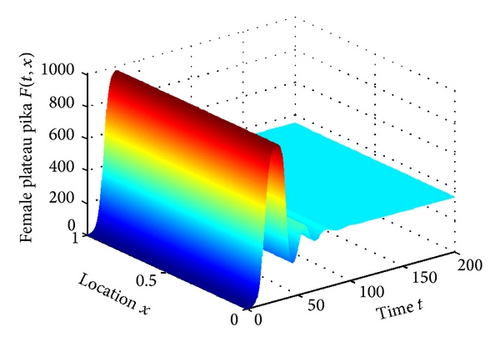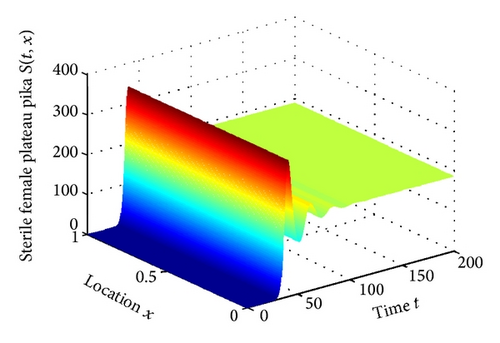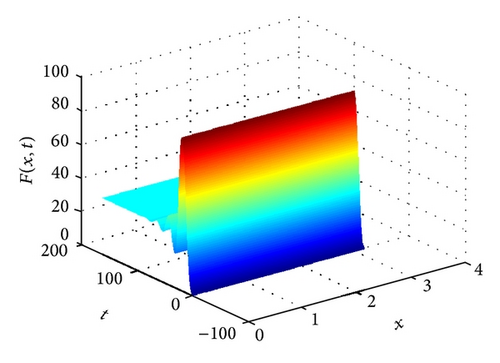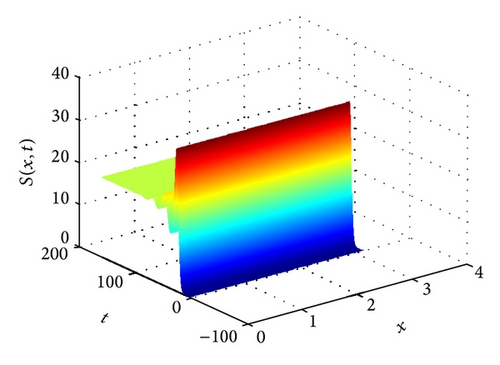Dynamical Analysis of a Plateau Pika with Cross-Diffusion under Contraception Control
Abstract
A plateau pika model with spatial cross-diffusion is investigated. By analyzing the corresponding characteristic equations, the local stability of an coexistence steady state is discussed when d21 is small enough. However, when d21 is large enough, the model shows Turing bifurcation if B2 − 4AC > 0. Furthermore, it is proved that if, R > R0, βK > d and cross-diffusion rates are zero, the positive coexistence steady state is globally asymptotically stable. A nonconstant positive solution bifurcates from the coexistent steady state by the Leray-Schauder degree theory. Numerical simulations are carried out to illustrate the main results.
1. Introduction
Plateau pika (Ochotona curzoniae) is a species of small mammals in the Ochotonidae. According to the studies [1–4], it is found that the plateau pika’s burrows are the primary homes to a wide variety of small birds and lizards since Qinghai-Tibet area owns the treeless environment and also minimize soil erosion for the suitable number of plateau pikas, enhance the ability of soil to absorb precipitation, contribute to nutrient cycling, and create microhabitats resulting in increased plant species richness; it serves as the main prey for most of the predatory animals on the plateau. Hence, the plateau pika is a keystone species in Qinghai-Tibet plateau. Since people overgraze and climate becomes warm, which makes the alpine meadow degrade seriously and provides the suitable environment for the plateau pika, multiplication of plateau pika is overabundance. According to the statistics data [1–4], there exists the huge number of the plateau pikas in this areas, and it threatens the forage that could otherwise be utilized by the livestock and the huge number of burrows results in soil erosion, vegetation disturbances, and the individuals who ride horses across the grasslands hazard. Hence plateau pika has been listed as a pest for the Chinese Government.
During the recent years, the various methods are applied to manage the number of plateau pikas. In the first stage, since people are lacking enough understanding about the plateau pika, they directly poisoned the plateau pike with botulin of models C and D. The people considered the plateau pika as rodent; in fact, pikas belong to lagomorphs and not to rodents. From the first paragraph, plateau pike is keystone species, whose elimination or major decimation from an ecosystem would have a greater average effect on other species’ populations or ecosystem processes. Hence, plateau pika contributes to maintaining the biodiversity in Qinghai-Tibet plateau [1, 2]. Obviously it does not work for the people to kill the plateau pika with any chemical sterilant. For the balance of the ecology and long-term development, immunocontraception has been used to manage plateau pika. Immunocontraception is different from the traditional method to manage the plateau pika. It aims to reduce the birth rate of the plateau pika and increase the death rate of the plateau pika. This control method can make the plateau pika be maintained at a low or suitable level for a long period. If we carry out the control method at the breeding season, the number of plateau pikas may be controlled at a desirable level. Several mathematical models describing the plateau pika under sterile control have been employed and analyzed. Dobson et al. [5] show that family structure has a strong influence on pika gene dynamics even though mating patterns of plateau pikas are variable. Smith and Cheeseman [6] show that a permanent contraceptive can give the chances of disease eradication which were very similar to that of lethal control. Burkey and Stenseth [7] discuss the effects of resource patchiness and the effects of a seasonal environment on the population dynamics of the herbivore species. Liu et al. [8] proposed a discrete model incorporating the sterile and the lethal control. In this model, the reproductive number plays a key role in impacting the dynamics of the model. Liu and Li [9] build a mathematical model to discuss the single species population under contraceptive control and lethal control. They studied the stability of the equilibrium of the model. Liu et al. [10] use a cellular-automata model to investigate the influence of grazing on dynamics of plateau pika population. The dispersal dimension depends on the meadow degradation.
Animal populations may not be distributed randomly in space but exhibit spatial patterns, and plateau pika is not exception. Plateau pika spatial distribution in the plateau is directly affected by individual interactions and interspecific interactions. Plateau pika dispersing is a natural phenomenon. Pikas from the different plateaus often contact and move towards favorable habitats due to climate, food, predators, and so on. This phenomena can employ random diffusion combined with directed movement upward along environmental gradients. Many interesting papers investigating species diffusion have been discussed by many authors. In [11], there is no difference in the average distance dispersed by the male and female sexes, since the costs and benefits of dispersal do not differ between males and females in the species. Dispersal movements in [12] result in equalization of density among pika families, if competition for environmental resources influenced dispersal. Wang and Li [13, 14] discuss the positive stationary problems in population cross-diffusion using the bifurcation theory. Pang and Wang [15] consider the positive solution for the population cross-diffusion. Cross-diffusion inducing the Turing bifurcation can also be studied by [16–20]. One can refer to [13–29] and references therein for more details. Although there are many references which discussed the population diffusion and cross-diffusion, plateau pika population diffusion or cross-diffusion under contraception still remains a problem. At the best of our knowledge as the authors known, we do not find any relative report or study until now. Hence pikas diffusion is very interesting and is worth studying.
This paper is organized as follows. Section 2 introduces a plateau pika model under contraceptive control and lethal control. In Section 3, local stability of the positive steady state is studied. In Section 4, we obtain persistence of the system. In Section 5, global stability and existence of the nonconstant steady state are investigated. The conclusion is given and some simulations to illustrate the theoretical results.
2. The Model Formulation
Here, b is the birth rate, d is mortality rate, the intrinsic growth rate r = b − d, μ is the death rate due to chemical sterilant, K denotes the carrying capacity, and β is efficient transmitted rate from female plateau pika to sterile female plateau pika though the contact. For the biological meaning of the model, b − d > 0 holds in the procession. They obtain the following lemma. Define R = b − d − μ, R0 = (b − d)(μ + d)/βK, and then it is easy to compute E** = (F*, S*) = ((d + μ)/β, (R − R0)K/(b − d + βK)).
Lemma 1. When R > R0 and βK > d, the positive equilibrium E** is globally asymptotically stable.
For the convenience to study the dynamics of (3), we first give the classical results for the elliptic equation.
Lemma 2 (Harnack inequality [30]). Assume that c ∈ C(Ω) and let be a positive solution to
Lemma 3 (maximum principle [25]). Suppose that . Assume that satisfies
3. Stability of Steady States
Case 1. Consider d12 = d21 = 0.
In this case, it is easy to get the characteristic equation of the coexistence steady state w* as follows:
Theorem 4. If R > R0, βK > d, and d12 = d21 = 0, then the positive coexistence steady state w* of (3) is locally asymptotically stable. In this case, Turing instability does not occur for (3).
Case 2. Consider d12d21 ≠ 0.
From the computation and notations, the trace of ℒ is less than 0, A > 0, and C > 0. Since μi ≥ 0, a necessary condition for w* of (3) becoming unstable is that detℒ for some μi is less than 0. Since μi is always nonnegative, the symmetric axis of the curve Ax2 − Bx + C must be at the right half plane, so B must be positive; that is, d21 > βd12S* + d2(b − d)/K. At the same time, the equation of Ax2 − Bx + C = 0 must have two positive roots; then B2 − 4AC > 0 must be satisfied for the instability of the positive coexistence steady state. Hence, has two positive roots
It is easy to know that, if μ1 < μi < μ2 for some μi ≥ 0, then det{ℒ} < 0. Therefore, we have the following theorem.
Theorem 5. Assume R > R0, and βK > d hold. If d21 > βd12S* + d2(b − d)/K, and B2 − 4AC > 0, then the positive coexistent steady state w* is unstable and (3) exhibits Turing bifurcation provided that, for some μ1 < μi < μ2, i = 1,2, ….
Remark 6. From the definition of B, it is easy to get the following.
- (i)
When d21 = 0, d12 ≠ 0, B = −d2(b − d)F*/K − d12βS*F* < 0. Then Turing bifurcation does not appear in (3).
- (ii)
When d12 = 0, d21 ≠ 0 or d12 ≠ 0, d21 ≠ 0, and d21 is large enough, which make B > 0 and B2 − 4AC > 0, there exists some μi > 0, such that μ1 < μi < μ2. Under this situation, w* is unstable while w* is stable for the ODE situation. Hence, Turing bifurcation may emerge in (3) if the cross-diffusion coefficients of the sterile female plateau pika d21 is large enough.
4. A Priori Estimation
In the following, we will discuss the upper bounds and the lower bounds by using Lemma 2 and Lemma 3. By the regularity theory for elliptic equations, it is easy to know that the positive solution of (19) is in .
Theorem 7. Assume that d12/d1, d1/d2, d12/d2, d21/d2 are bounded; then there exist positive constants Ci, i = 1,2, such that the positive solution w of (19) satisfies
Proof. For using the Lemma 3, we set ϕ = d1F + d12SF, ψ = d1F + d2S + (d12 + d21)SF then elliptic equation (19) becomes
Let such that . By the first equation of (19) and Lemma 3, we have F(x1) ≤ K, and S(x1) ≤ K. Then, by the denotation of ϕ, we have
From Theorem 7, the population of plateau pika for (3) is boundary. Since the maximum capability carrying has limitation, the population of the plateau pika for (3) can not tend infinity. For proving the persistence of the plateau pika, we can obtain the following theorem.
Theorem 8. Assume that d12/d1, d1/d2, (d12 + d21)/d2 are bounded; then there exist positive constants ci, i = 1,2, such that the positive solution w of (19) satisfies
Proof. Since
Now we need to estimate the positive lower bound of S. Suppose, on the contrary, that does not hold. Define . Then there exists a sequence with (d1n, d2n, d12n, d21n)∈[d, ∞)×[d, ∞)×(0, ∞)×(0, ∞) such that the corresponding positive solutions wn of (19) satisfy
Taking the limit and integrating the second equation of (29), we have
By Theorems 7 and 8, we can define a set
5. Global Stability of the Steady State and the Existence of Nonconstant Positive Solution
In order to discuss the existence of nonconstant positive solution of (3), we first prove the global stability of the coexistence equilibrium w*, when the cross-diffusion coefficients are zero. Then there is no nonconstant solution with respect to elliptic equation (19). We obtain the following theorem.
Theorem 9. Assume R > R0, βK > d. The positive coexistence equilibrium of (3) is globally asymptotic stable when the cross-diffusion coefficients are zero; that is, (19) has no nonconstant positive solution.
Proof. Let f* = 1/|Ω|∫Ω f dx for any f ∈ L1(Ω). We denote the Lyapunov function as follows:
Lemma 10. If G(μi) ≠ 0, then the number of negative eigenvalues of DwL(w*) on Xij is odd if and only if G(μi) < 0, for each 1 ≤ j ≤ dimE(μi). In addition,
Lemma 11. Assume R > R0, βK > d. Then the two roots and of 𝒜(μ, d21) are real and satisfy the following limits for some such that, for all the ,
Next we will discuss the existence of nonconstant positive solution of (19) with respect to the cross-diffusion coefficient d21.
Theorem 12. Assume that the other parameters in (19) are fixed except d21, and R > R0, βK > d hold. is given by the limit in (51). If for some n ≠ 1, and the sum is odd, then there exists a positive constant , such that, if , there exists at least one nonconstant positive solution which bifurcates from the coexistence steady state of (19).
Proof. Due to Lemma 11, there exists a positive , if ; then there exists two positive roots for 𝒜(μ, d21) and
For t ∈ [0,1], define
It is easy to check that L(1; w) = L(w), Theorem 9 indicates that L(0; w) = 0 has only the positive solution w* in X+. Dividing L(t; w) with respect to w, we have
By the definition of G(μ), 𝒜(μ, d21) and Lemma 10, for t = 1, we have
In addition, L(t; w) ≠ 0 on ∂ℬ(c) for all t ∈ [01] by Theorems 7 and 8, while we use the homotopy invariance of the topological degree to obtain
6. Simulation and Discussion
We can illustrate the theoretical results through two simulatinon examples. Set b = 0.749, d = 0.3311, K = 100, β = 0.01, μ = 0.01, d1 = 0.2, d2 = 0.3, d12 = 0, d21 = 0. It is easy to get that R = 0.4079 > R0 = 0.425 and βK = 1 > d = 0.3311 satisfy the conditions of Lemma 1. System (3) with above coefficients has a unique positive steady state w* = (34.11,18.7146). By Theorem 9, we see that the coexistence steady state w* of (3) is globally stable.
Numerical simulation illustrates our result (see Figure 1). Then we let d12 = 0.01, d21 = 0, and other parameters be the same as Figure 1. System (3) with above coefficients still has a unique positive steady state w* which is the same as Figure 1. By Theorem 5, we see that the coexistence steady state w* of problem (3) is locally stable. Numerical simulation illustrates our results (see Figure 2). We can also know that the pressure from the female plateau pika to sterile female plateau pika diffusion d12 does not change the stability of system (3). However, we also find that the diffusion can advance the time for both the female plateau pika and the sterile female plateau pika to arrive at the coexistence steady state.




For the management of the application, larger β resulted in small number of the plateau pikas. Hence we should try our best to combine a powerful contraception method with some additional measures to control the plateau pikas. In addition, the diffusion can advance the time for both the female plateau pika and the sterile female plateau pika to arrive at the coexistence steady state. Increasing the cross-diffusion coefficients can rich the dynamics of the model and enhance the difficulty of the control. The system may show the Turing bifurcation.
Unfortunately, we are unable yet to study global stability of coexistence steady state w* when d12 ≠ 0, d21 = 0. In addition, we do not study the dynamics of (3) when B2 − 4AC = 0. In this case detℒ = 0, the system may exhibit steady state bifurcation.
Conflict of Interests
The authors declare that they have no conflict of interests.
Acknowledgments
This study is supported by the NSF of China (61203228, 61275120, and 11371313), Mathematical Tianyuan Foundation (11226258), the Young Sciences Foundation of Shanxi (2011021001-1), the Natural Science Foundation of Shanxi Province (2013011002-5), program for the Outstanding Innovative Teams of Higher Learning Institutions of Shanxi, and the “131” talents.




